- Table of Contents
- Related Documents
-
| Title | Size | Download |
|---|---|---|
| 01-Text | 862.55 KB |
Overview
Table 1 PSR2400-54D power module features
|
Feature |
Description |
|
Protection |
Protection against input under-voltage, input over-voltage, output over-voltage, output short circuit, output under-current, output over-current, and overheat. |
|
Redundancy |
The power modules can operate in N+1 or N+N redundancy. For more information, see "Power module configuration." |
|
Hot swapping |
You can install or remove a power module when the device is operating. |
The power module shuts down automatically when its temperature exceeds the acceptable range. When the temperature returns to the acceptable range, the power module automatically restarts.
Front panel
Figure 1 Front panel
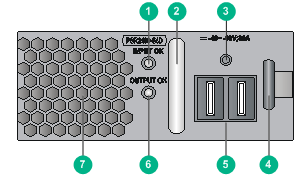
|
(1) Power input LED |
(2) Handle |
|
(3) Screw hole for fastening the power cord connector |
|
|
(4) Latch |
(5) DC-input receptacle |
|
(6) Power output LED |
(7) Air vents |
LEDs
The PSR2400-54D power module has two LEDs.
Table 2 LED description
|
LED |
Mark |
Color |
Description |
|
Power input LED |
INPUT OK |
Off |
No DC power input. |
|
Low DC input voltage. The power module has entered protected state. |
|||
|
Green |
Normal DC input. |
||
|
Power output LED |
OUTPUT OK |
Green |
Normal DC output. |
|
Red |
DC output failure. An alarm condition occurs, for example, output short circuit, output over-current, output over-voltage, output under-voltage, or remote shutdown. The power module has entered the protected state. |
||
|
Orange |
High temperature. |
|
|
NOTE: After the circuit breaker of the power module is switched off, the LEDs on the power module will remain on for a while. |
Technical specifications
Table 3 Technical specifications
|
Item |
Specifications |
|
|
Rated input voltage |
–48 V to –60 V |
|
|
Rated output voltage |
54 V |
|
|
Maximum input current |
80 A |
|
|
Maximum output current |
44.5 A |
|
|
Maximum output power |
2400 W |
|
|
Dimensions (H × W × D) |
41 × 100 × 332 mm (1.61 × 3.94 × 13.07 in) |
|
|
Ambient temperature |
Operating temperature |
–10°C to +50°C (–14°F to +122°F) |
|
Storage temperature |
–40°C to + 70°C (–40°F to +158°F) |
|
Power module configuration
Follow these guidelines to configure power modules for the device:
· Determine the total number of power modules based on the actual power consumption, the power module slot number, and power redundancy design.
· Determine the power module redundancy design based on the power source conditions.
¡ When two mains power inputs are provided, you can configure the power modules in N+N redundancy. N+N must be not greater than the total number of power module slots.
¡ When one mains power input is provided, you can configure the power modules in N+1 or N+N redundancy. N+1 or N+N must be not greater than the total number of power module slots.
· For easy usage and maintenance, configure a circuit breaker for each power input. The rated current of the circuit breaker must be a minimum of 120 A.
Installing and removing the power module
Installing the power module
To avoid bodily injury and device damage, follow the procedures in Figure 2 to install a power module.
Figure 2 Power module installation procedure
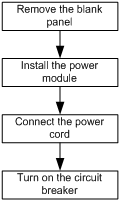
Before the installation, prepare an ESD wrist strap and a flat-blade screwdriver yourself.
Installing the power module
1. Wear an ESD wrist strap, and make sure the strap makes good skin contact and is reliably grounded.
2. Remove the blank panel from the target power module slot.
¡ If the blank panel is as shown in Figure 3, thread the flat-blade screwdriver through the hole in the handle of the blank panel and pull the blank panel out.
¡ If the blank panel is as shown in Figure 4, put your forefinger in the hole in the blank panel and pull the blank panel out.
Skip this step if the target slot does not have any blank panel installed.
Figure 3 Removing a blank panel (1)
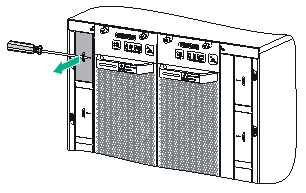
Figure 4 Removing a blank panel (2)
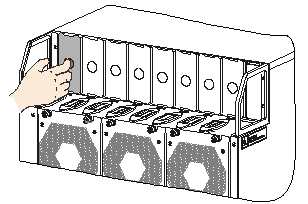
3. Unpack the power module.
4. Correctly orient the power module.
If you install the power module in a left power module slot, make sure the latch is above the handle. If you install the power module in a right power module slot, make sure the latch is below the handle.
5. Holding the handle of the power module with one hand and supporting the bottom of the power module with the other, slide the power module along the guide rails into the slot until you hear a click.
The power module is foolproof. If the power module is oriented incorrectly, you cannot install the power module into the slot. If you encounter a hard resistance while inserting the power module, pull out the power module, reorient it, and then insert it again.
Figure 5 Installing the power module
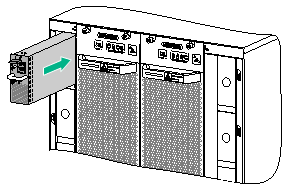
Connecting the power cord
|
|
WARNING! · Make sure each power cord has a separate circuit breaker. · Before you connect the DC power cord to the DC source terminal block. Make sure the circuit breakers are turned off. |
To connect the power cord:
1. Insert the power cord connector into the DC input receptacle on the power module.
2. Fasten the screw to secure the connector in place.
3. Connect the two wires at the other end of the DC power cord to the DC source terminal block.
Removing the power module
To avoid device damage and bodily injury, follow the procedures in Figure 6 to remove the power module.
Figure 6 Power module removal procedure
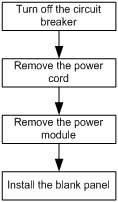
Before you remove the power module, prepare an ESD wrist strap yourself.
Removing the power cord
1. Turn off the circuit breaker of the power cord.
2. Wear an ESD wrist strap, and make sure the strap makes good skin contact and is reliably grounded.
3. Loosen the screw that secures the power cord connector to the power module, and pull the power cord out.
Removing the power module
|
|
CAUTION: · Before you insert a removed power module into a power module slot, make sure the LEDs on the power module are off. · Avoid scalding your hands when you remove the power module. |
To remove the power module:
1. Pressing the latch towards the handle direction, pull the power module out along the guide rails until it is part way out of the slot.
2. As shown in Figure 7, grasping the handle of the power module with one hand and supporting the bottom of the power module with the other hand, pull the module slowly along the guide rails out of the slot.
Figure 7 Removing the power module
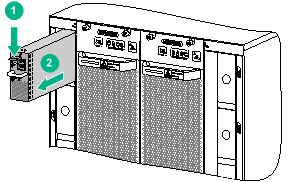
3. Place the power module on an antistatic mat.
4. Install the blank panel in the power module slot.

